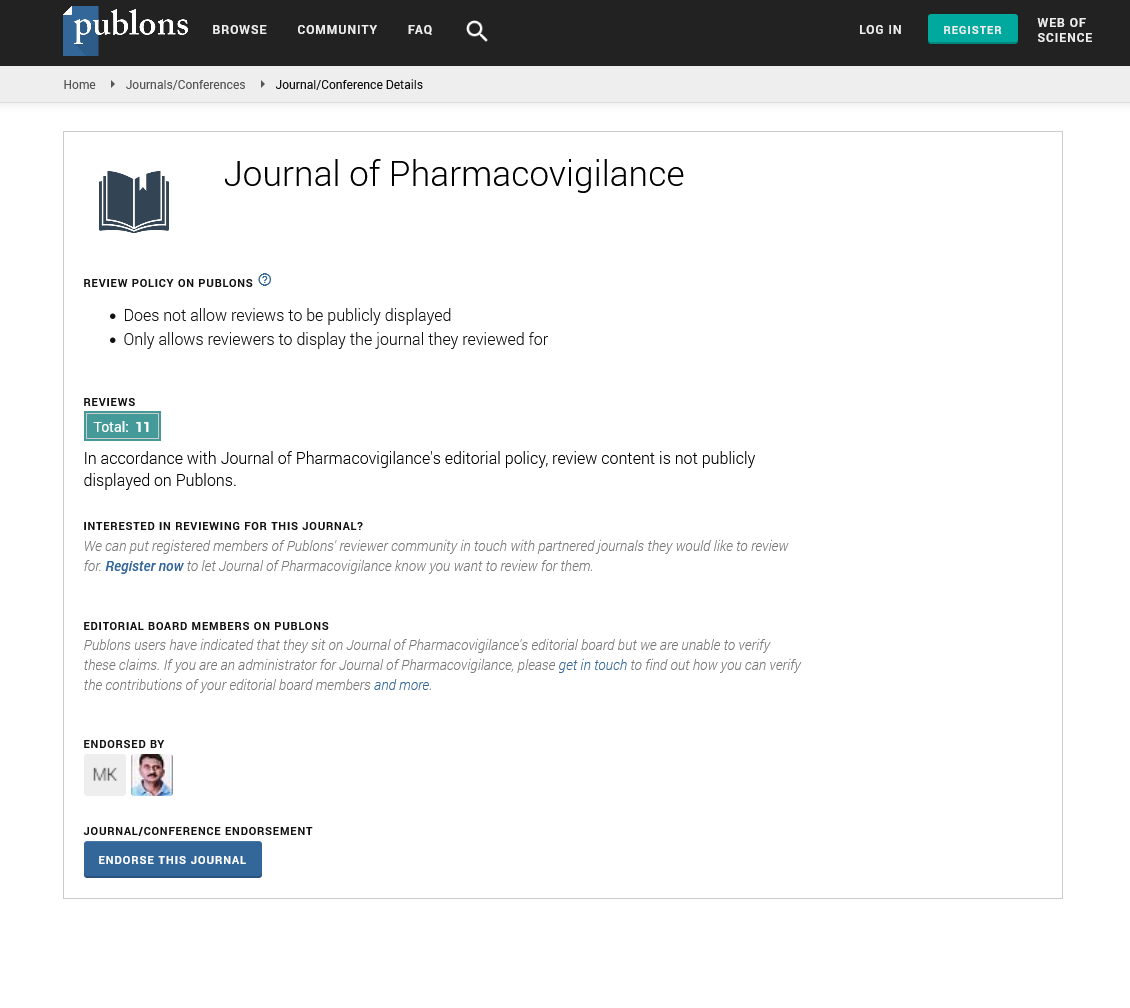Indexed In
- Open J Gate
- JournalTOCs
- The Global Impact Factor (GIF)
- RefSeek
- Hamdard University
- EBSCO A-Z
- OCLC- WorldCat
- Publons
- Euro Pub
- Google Scholar
Useful Links
Share This Page
Journal Flyer

Open Access Journals
- Agri and Aquaculture
- Biochemistry
- Bioinformatics & Systems Biology
- Business & Management
- Chemistry
- Clinical Sciences
- Engineering
- Food & Nutrition
- General Science
- Genetics & Molecular Biology
- Immunology & Microbiology
- Medical Sciences
- Neuroscience & Psychology
- Nursing & Health Care
- Pharmaceutical Sciences
Commentary - (2024) Volume 12, Issue 2
Evaluating the Impact of Educational Interventions on Pharmacovigilance Practices
Takada Ryoichi*Received: 29-May-2024, Manuscript No. JP-24-25984; Editor assigned: 31-May-2024, Pre QC No. JP-24-25984(PQ); Reviewed: 14-Jun-2024, QC No. JP-24-25984; Revised: 21-Jun-2024, Manuscript No. JP-24-25984(R); Published: 28-Jun-2024, DOI: 10.35248/2329-6887.24.12.477
About the Study
Pharmacovigilance, the science of monitoring drug safety, is essential for patient well-being. However, underreporting of Adverse Drug Reactions (ADRs) remains a significant challenge. Educational interventions are proposed methods to improve pharmacovigilance practices among healthcare professionals. This manuscript outlines a study protocol to evaluate the effectiveness of educational programs in enhancing ADR reporting and overall pharmacovigilance practices.
Medication safety is a fundamental of quality healthcare. Pharmacovigilance, the systematic monitoring of the safety of medicinal products, plays a critical role in identifying, assessing, and preventing ADRs. Despite its importance, underreporting of ADRs is a pervasive issue, hindering the ability to detect and address potential drug safety concerns.
Limited knowledge, unclear reporting procedures, and time constraints are frequently cited barriers to effective pharmacovigilance practices among healthcare professionals. Educational interventions have emerged as a potential strategy to improve knowledge, attitudes, and reporting behaviors related to pharmacovigilance. This study aims to evaluate the effectiveness of such interventions in enhancing pharmacovigilance practices among healthcare professionals.
A prospective, single-blinded, controlled trial will be conducted. Participants will be unaware of their group assignment (intervention or control) until data collection is complete.
Healthcare professionals involved in medication administration and patient care, including physicians, nurses, and pharmacists, will be recruited from participating hospitals and clinics. Inclusion and exclusion criteria will be established to ensure a representative sample.
The intervention group will receive a structured educational program on pharmacovigilance principles, ADR identification, and reporting procedures. This program may encompass interactive lectures, workshops, case studies, and online learning modules customized to the target audience. The control group will receive standard information on pharmacovigilance available through existing institutional channels.
The primary outcome will be the rate of ADR reporting by healthcare professionals in the intervention and control groups following the educational intervention. Secondary outcomes will include:
• Knowledge of pharmacovigilance principles assessed through pre- and post-intervention questionnaires.
• Attitudes towards ADR reporting measured by validated scales.
• Self-reported confidence in identifying and reporting ADRs.
• Time spent on pharmacovigilance activities, if feasible.
Data will be collected at baseline (pre-intervention) and at a designated follow-up period (post-intervention).
• Standardized questionnaires will be used to assess knowledge, attitudes, and confidence levels regarding pharmacovigilance.
• ADR reporting rates will be obtained from the hospital pharmacovigilance database or a dedicated reporting system implemented for the study.
• Self-reported data on time spent on pharmacovigilance activities, if included, may be collected through time-use diaries or surveys.
Data will be analyzed using appropriate statistical methods. The primary outcome (ADR reporting rate) will be compared between the intervention and control groups using chi-square tests or logistic regression models. Secondary outcomes will be analyzed using paired t-tests or Wilcoxon signed-rank tests for within-group comparisons and independent t-tests or Mann- Whitney U tests for between-group comparisons.
The study will be conducted in accordance with the ethical principles outlined in the Declaration of Helsinki. Informed consent will be obtained from all participants. Confidentiality of participant data will be ensured throughout the study.
This study will contribute to the growing body of evidence on the effectiveness of educational interventions in promoting pharmacovigilance practices. By improving the knowledge, attitudes, and reporting behaviors of healthcare professionals, educational interventions can potentially lead to a more strong pharmacovigilance system and ultimately contribute to safer medication use.
The limitations of this study include potential for selection bias (participants who choose to participate may be more interested in pharmacovigilance) and social desirability bias (participants may over-report positive behaviors) in self-reported outcomes. Additionally, the generalizability of findings may be limited depending on the study population and healthcare setting.
Conclusion
Evaluating the impact of educational interventions on pharmacovigilance practices is crucial for identifying effective strategies to improve medication safety. This study will provide valuable insights into the role of education in empowering healthcare professionals to contribute to a more comprehensive and effective pharmacovigilance system.
Citation: Ryoichi T (2024) Evaluating the Impact of Educational Interventions on Pharmacovigilance Practices. J Pharmacovigil. 12:477.
Copyright: © 2024 Ryoichi T. This is an open-access article distributed under the terms of the Creative Commons Attribution License, which permits unrestricted use, distribution, and reproduction in any medium, provided the original author and source are credited.

